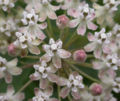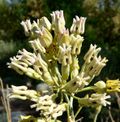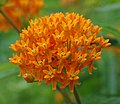Asclepias
| Asclepias subsp. var. | ||||||||||||||||||||||||||||||||||||||||||||||||||||||||
|---|---|---|---|---|---|---|---|---|---|---|---|---|---|---|---|---|---|---|---|---|---|---|---|---|---|---|---|---|---|---|---|---|---|---|---|---|---|---|---|---|---|---|---|---|---|---|---|---|---|---|---|---|---|---|---|---|

|
|
| ||||||||||||||||||||||||||||||||||||||||||||||||||||||
| ||||||||||||||||||||||||||||||||||||||||||||||||||||||||
Asclepias L. (1753), the milkweeds, is a genus of herbaceous perennial, dicotyledonous plants that contains over 140 known species. It previously belonged to the family Asclepiadaceae, but this is now classified as a subfamily Asclepiadoideae of the dogbane family Apocynaceae.
Milkweeds are an important nectar source for bees and other nectar seeking insects, and a larval food source for monarch butterflies and their relatives, as well as a variety of other herbivorous insects (including numerous beetles, moths, and true bugs) specialized to feed on the plants despite their chemical defenses. Milkweed is named for its milky juice, which contains alkaloids, latex, and several other complex compounds including cardenolides. Some species are known to be toxic.
Carolus Linnaeus named the genus after Asclepius, the Greek god of healing, because of the many folk-medicinal uses for the milkweed plants.
Pollination in this genus is accomplished in an unusual manner. Pollen is grouped into complex structures called pollinia (or "pollen sacs"), rather than being individual grains or tetrads, as is typical for most plants. The feet or mouthparts of flower visiting insects such as bees, wasps and butterflies, slip into one of the five slits in each flower formed by adjacent anthers. The bases of the pollinia then mechanically attach to the insect, pulling a pair of pollen sacs free when the pollinator flies off. Pollination is effected by the reverse procedure in which one of the pollinia becomes trapped within the anther slit.
Asclepias species produce their seeds in follicles. The seeds, which are arranged if overlapping rows, have white silky filament-like hairs known as pappus, silk, or floss. The follicles ripen and split open and the seeds, each carried by several dried pappus, are blown by the wind.
Milkweeds use three primary defenses to limit damage caused by caterpillars: hairs on the leaves, cardenolid toxins, and latex fluids. Data from a DNA study indicates that more recently evolved milkweed species utilize less of these preventative strategies, but grow faster than older species; potentially regrowing faster than caterpillars can consume them.[1]
| Standard Cyclopedia of Horticulture |
|---|
|
Asclepias (ancient Greek and Latinized name). Asclepiadaceae. Milkweed. Silkweed. Perennial milky-juiced herbs, sometimes used in the hardy border or wild garden. Erect, with deep thick and hard perennial roots: Lvs. opposite or verticillate (rarely alternate), entire: fls. gamopetalous, the corolla segms. generally strongly reflexed; stamens 5, attached to the corolla, the anthers more or less united about the stigma; between the corolla and the stamens is a crown of 5 cornucopia-like horns or appendages; pollen cohering into a waxy mass (pollinium) which is removed bodily by insects that visit the fl.: fr. 2 warty, or echinate or smooth follicles. The pollination of an asclepias fl. is shown in Fig. 398. The pollen-masses are usually twin (as at 6), and the handle or caudicle lies in a chink on the side of the stigma. The pollen-masses become attached to the legs or mouth parts of the insect, and are thereby transferred to another fl.—The milkweeds are common in waste places in N. Amer., and are rarely cult. About 80 species are known, mostly North American, but others in Cent, and S. Amer. and Afr. Several species (described below) have been offered by dealers in native plants. The butterfly-weed and some others are very showy and worthy of more general attention. The large-lvd. kinds are desirable when heavy foliage effects are wanted. They are all perennials of the easiest cult. Prop, by division, rarely by seeds.
|
Describe the plant here...
Cultivation
Propagation
Pests and diseases
Species
Some Asclepias species:
| Asclepias albicans | Whitestem milkweed | |
| Asclepias amplexicaulis | Blunt-leaved milkweed | |
 |
Asclepias asperula | Antelope horns |
 |
Asclepias californica | California milkweed |
 |
Asclepias cordifolia | Heart-leaf milkweed |
| Asclepias cryptoceras | Pallid milkweed | |
 |
Asclepias curassavica | Scarlet milkweed, Tropical milkweed, Bloodroot, Bloodflower, Bastard Ipecacuanha |
| Asclepias eriocarpa | Woollypod milkweed | |
 |
Asclepias erosa | Desert milkweed |
| Asclepias exaltata | Poke milkweed | |
 |
Asclepias fascicularis | Narrow leaf milkweed |
 |
Asclepias fruticosa syn. Gomphocarpus fruticosus | swan plant, African milkweed |
| Asclepias humistrata | Sandhill milkweed | |
 |
Asclepias incarnata | Swamp milkweed |
| Asclepias lanceolata | Lanceolate milkweed | |
| Asclepias linaria | Pine needle milkweed | |
| Asclepias linearis | Slim milkweed | |
| Asclepias meadii | Mead's milkweed | |
 |
Asclepias nyctaginifolia | Mojave milkweed |
| Asclepias obovata | Pineland milkweed | |
 |
Asclepias physocarpa | Gomphocarpus physocarpus, commonly balloonplant, balloon cotton-bush, giant swan plant, testicle tree, bishop's balls or swan plant |
 |
Asclepias purpurascens | Purple milkweed |
| Asclepias quadrifolia | Four-leaved milkweed | |
| Asclepias rubra | Red milkweed | |
| File:Asclepiassolanoana.jpg | Asclepias solanoana | Serpentine milkweed |
 |
Asclepias speciosa | Showy milkweed |
 |
Asclepias subulata | Rush milkweed(Leafless milkweed) |
| Asclepias sullivantii | Sullivant's milkweed | |
 |
Asclepias syriaca | Common milkweed |
 |
Asclepias tuberosa | Butterfly weed, Pleurisy root |
| Asclepias variegata | White milkweed | |
 |
Asclepias verticillata | Whorled milkweed |
| Asclepias vestita | Woolly milkweed | |
| Asclepias vincetoxicum | ||
 |
Asclepias viridiflora |
Gallery
-
photo 1
-
photo 2
-
photo 3
References
- ↑ Ramanujan, Krishna (Winter 2008). "Discoveries: Milkweed evolves to shrug off predation". Northern Woodlands (Center for Northern Woodlands Education) 15 (4): 56.
- Standard Cyclopedia of Horticulture, by L. H. Bailey, MacMillan Co., 1963
External links
- w:Asclepias. Some of the material on this page may be from Wikipedia, under the Creative Commons license.
- Asclepias QR Code (Size 50, 100, 200, 500)
